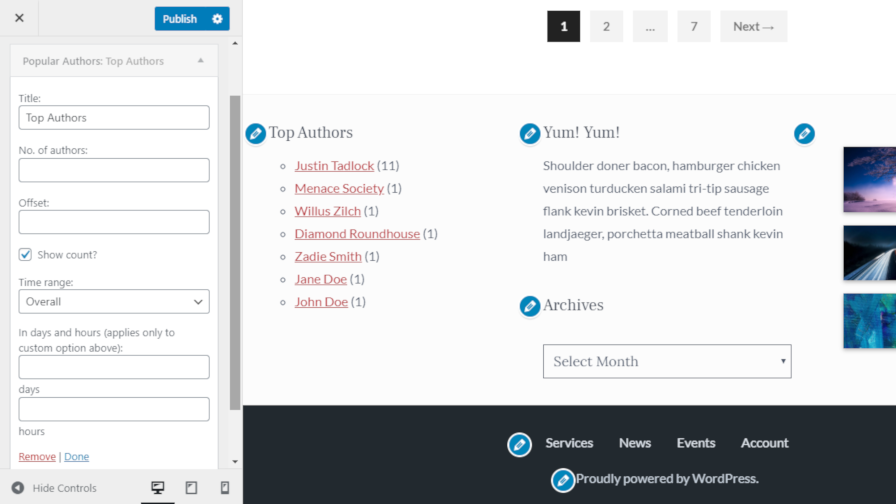Ajay D’Souza Releases Popular Authors Add-On for Top 10 Plugin
Ajay D’Souza released the Popular Authors plugin last week, which is designed to display authors by the number of post views they have reached. It is an add-on for his Top 10 plugin and uses the underlying data to build the popular authors list. Websites with multiple authors could use it to provide further insight into what its visitors should read.
The Top 10 parent plugin is a page-view tracker and allows end-users to display popular posts. However, it also has the potential to serve as a framework for tracking or displaying various WordPress elements by popularity. For example, a developer could build a popular category plugin to show categories with the most-viewed posts. Top 10 includes an API for developers to build upon its data collection, which is what D’Souza has done with the Popular Authors plugin.
The version 1.0 release of Popular Authors is relatively basic. It provides the bare-bones features that are necessary for outputting a simple list of links. The plugin works well enough to provide a solution for users who need an easy way of displaying author popularity.
Both Popular Authors and Top 10 are alternatives to collecting view counts without relying on major companies or possibly running afoul of data tracking laws. All of the data is stored directly in the WordPress database. No personal data of visitors is collected. Both plugins should be compliant with the GDPR and other privacy-related regulations and laws. However, because the data is stored directly on the site as opposed to offloading it to a third party, it will use more resources to save that data on each page load. This is a minimal cost for most.
How the Plugin Works

Using Popular Authors should be simple for the average user. The plugin provides a widget named “Popular Authors” and a [wzpa_popular_authors] shortcode. Both methods of outputting the popular list offer several configuration options.
When installed and activated, the plugin gathers the data collected by the Top 10 parent plugin and sorts that data by post author. The primary options for both the widget and shortcode are the following:
- The number of authors.
- Offset (i.e., skip) authors at the top of the list.
- Whether to display the post view count.
- Popularity within a time range, which can be further configured by days and hours.
The time range option is arguably the most important. Without setting it, authors are sorted by all-time post views. Depending on the site, all-time data may not be representative of current popularity. Setting this option to use a more recent timeframe will sort authors more accurately on their recent posts.
The shortcode has far more options for configuring its output. For users who need extra control, they will likely find it more flexible than the widget. The shortcode documentation lists all of the available parameters.
It is worth noting that by installing the Top 10 parent plugin, it will add two extra database tables to your site named *_top_ten and *_top_ten_daily. This is necessary for data collection.
Future Plans and Features
While the current 1.0 version of the plugin is basic, D’Souza has plans to build upon this foundation in upcoming versions. Right now, he is taking it one step at a time and listening to feedback from users.
In upcoming versions of the plugin, he plans to add a global settings page that allows users to set up defaults for how the plugin outputs its widget and shortcode. Currently, they must set display options on a case-by-case basis. “From experience, regular users prefer a place they can set and forget global options,” he said.
D’Souza wants to provide users with improved display options. The popular list currently outputs a text-based list. However, the goal is to allow users to show an author avatar and possibly expose a grid-based display.
A couple of versions down the road, he hopes to have a block that is on par with the widget and shortcode. He is also researching how he could add support for the Co-Authors Plus plugin so that post views are counted toward all authors of any given post. Both of these features are slated for the eventual version 1.2 release. For version 1.3, he plans to have REST API endpoints for fetching the top authors list.
“I’m still working out other features, but again very open to receive feedback,” said D’Souza. “A lot depends on the take-up of this plugin.”
Most of these features will be follow-ups to work that is going into version 3.0 of the Top 10 parent plugin. D’Souza has some major changes in the works. “This will include the Gutenberg block to display the top posts with several configuration settings similar to the shortcode,” he said. “Another feature is to also introduce the REST API endpoints for getting the top posts. Plus, I’m also experimenting with how I can use it to update the count which is currently through Ajax. The latter is the more challenging part I believe.”








